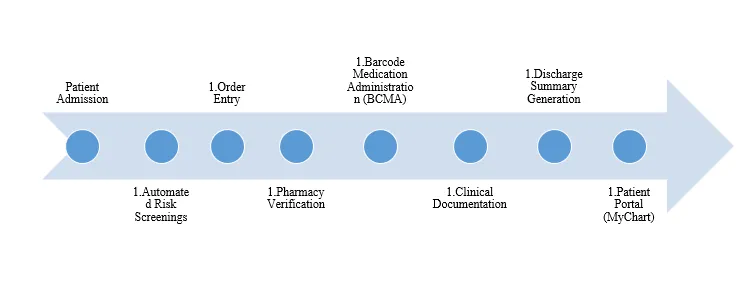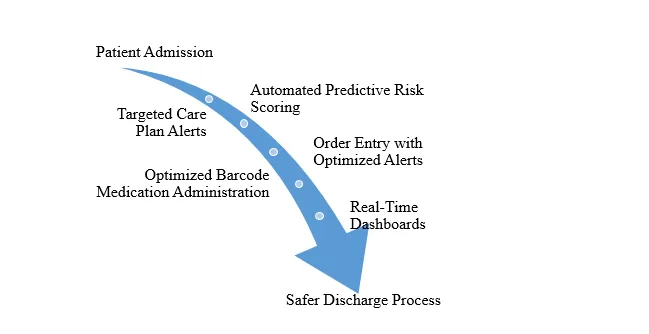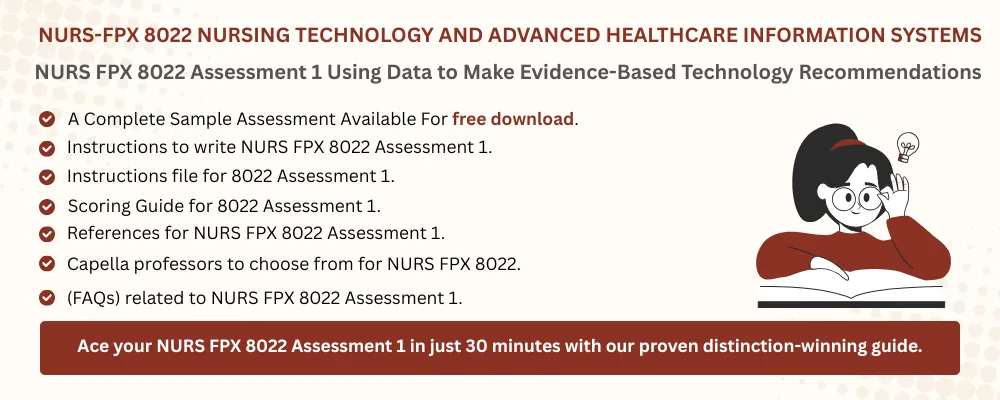NURS FPX 8022 Assessment 1 Sample FREE DOWNLOAD
NURS FPX 8022 Assessment 1 Using Data to Make Evidence-Based Recommendations
Student name
NURS-FPX 8022
Capella University
Professor Name
Submission Date
Using Data to Make Evidence-Based Recommendations
The adoption of technology in the healthcare setting has played a leading role in improving patient safety, clinical outcomes, and organizational performance. Massachusetts General Hospital (MGH), one of the best academic medical Centres in Boston, uses Epic electronic health records (EHR) to improve clinical documentation, workflow, and evidence-based decision making.
The article explains the benefits and problems of Epic EHR in the acute care environment, evaluates the performance of MGH with the help of Leapfrog and Medicare Compare data, and suggests an evidence-based informatics project to get higher scores and patient outcomes for the organization. If implemented correctly, EHRs can result in improved patient safety, more personalized treatment, and other clinical and administrative efficiencies.
Evaluation of Technology in Use
Being among the finest academic Medical Centres, the MGH has managed to deploy the EHR technology to improve the quality of care and the safety of patients (Massachusetts General Hospital, n.d.). Implementing Epic EHR in MGH has contributed to the reduction of medication errors through the assistance of embedded barcode medication administration (BCMA), automated allergy check, and real-time drug interactions notifications. The system will continue to support clinicians to access clinical decision-making tools that standardize care pathways and reduce variability in care (Syrowatka et al., 2023). It has also simplified the administration process and reduced the time spent on delays, as well as the paperwork from electronic ordering systems, discharge summaries, and centralized scheduling (Harbi et al., 2024). MGH also utilizes EHR data to monitor trends of hospital-acquired infections, benchmark, and create predictive risk models on which quality improvement efforts are based.
Finally, patients will be provided access to the MyChart portal and able to view results from their labs, interact with the providers, book an appointment, and enhance patient engagement and shared decision-making (Vanderhout et al., 2025). The EHR system can also be used to unify multidisciplinary care teams, ensuring that information about a patient is available in one real-time, department-wide source of truth (Calduch et al., 2021). However, issues such as provider alert fatigue, external system interoperability, and high maintenance expenses are still of concern. The case study of MGH demonstrates that properly used, EHR technology is an effective facilitator of safer, more coordinated, and patient-centered healthcare delivery.
The introduction of Epic EHR at MGH has no doubt changed the way patients are handled, but this has also come with challenges that affect day-to-day operations. The issue of provider burnout is one of the main ones because clinicians sometimes have to allocate lots of time to the documentation process instead of communicating with patients. Indeed, Arndt et al. (2022) reported that when working with EHR systems, physicians may spend almost two hours of documentation per hour of patient care. These interruptions in the workflow and loss of efficiency during high-volume shifts result from the lack of customization of templates to a particular specialty and the intrusion of system notifications into the clinical decision-making process (Shan et al., 2023). The issues highlight the lack of integration between the potential of technology and frontline utility. Thus, although Epic leads to safer care delivery, it also presents the risk of overloading providers with workflows that are not optimized to ease the administrative load.
The other critical issue is associated with the expensive nature and maintenance requirements of Epic EHR, which burden healthcare organizations. Even one large-scale Epic deployment can cost hundreds of millions of dollars and needs ongoing IT maintenance to update and problem-solve (Chishtie et al., 2023). However, interoperability of data remains a common challenge, and access to patient data in non-Epic systems and external partners is limited, slowing down care coordination and population health (Chishtie et al. 2023). According to Walker et al. (2023), despite national interoperability efforts, almost 46% of hospitals are able to share patient data outside the system on a regular basis. The problems show that well-established organisations like MGH must balance financial, technical, and operational realities to make the best use of EHR technology.
The Epic EHR system at MGH will be a part of the whole patient process, starting with admission and continuing with discharge. Demographic and clinical information is added to Epic at the time of admission, and this automatically initiates automated risk screening of falls, infections, and medication safety (Chishtie et al., 2023). The screenings alert providers and nurses about the possible risks early on in the hospitalization process. Providers then place electronic orders, and the pharmacy staff reviews all medication orders in Epic to help verify the safety and suitability of the medication.
The nurses scan the identification band of the patient and the barcode of the medication during the inpatient stay and use BCMA connected to Epic, thus allowing them to eliminate medication errors (Syrowatka et al., 2023). Clinical encounters and progress notes are documented directly into Epic, which in turn updates the electronic record of the patient in real time and provides continuity of care across multidisciplinary teams. Finally, Epic automatically generates discharge summaries and patient instructions during discharge, which enhance patient engagement and communication after discharge by transmitting them to the clinical team and the patient through the My Chart portal (Vanderhout et al., 2025).
Patient Safety Areas Identified
The MGH is a Leapfrog Hospital Safety Grade program participant that assesses hospitals based on patient safety performance in numerous areas. Most recent data shows that MGH has an overall grade of B. Though the hospital is performing well in a number of areas, its safety performance is inconsistent across domains. Medication safety was above average in the three chosen patient safety measures, which indicates that the hospital utilizes the Epic BCMA and decision support tools effectively (LeapFrog, n.d).
The rating of infection prevention was average, which means that it can be improved to help decrease the number of hospital-acquired infections, including central line-associated bloodstream infections and surgical site infections (LeapFrog, n.d). Nevertheless, patient falls and injury prevention scored below average, indicating that, even though EHR-based fall-risk screenings were implemented, additional specific measures are required to reduce fall-related injuries (LeapFrog, n.d). The findings demonstrate the advantages and disadvantages of the current safety practices at MGH that are technology-enabled.
In the Medicare Care Compare, acute care hospitals were considered as a provider type in order to compare the performance of MGH. The patient safety score of 3 out of 5 stars is average in relation to other similar institutions. Compared to peer academic medical centers, including Johns Hopkins Hospital, which has a 4-star patient safety score, MGH lags behind somewhat in its overall safety performance.
However, the other large tertiary center, the Cleveland Clinic, is also rated at 3 stars, which puts MGH in the same bracket with many of its peers, but remains worse than the national leaders (Medicare Compare, 2024). The comparison shows that MGH does a decent job, but with specific focus on infection prevention and fall reduction, the safety ratings can be improved, and the gap between it and the best hospitals can be narrowed.
Recommended Technology Implementation
By applying a group of specific, evidence-based informatics interventions to Epic, the MGH can improve the patient safety performance and advance a Leapfrog grade of B and a Medicare Care Compare rating of 3 stars to the highest level. The latter (Med-Safe+) would support closed-loop medication safety and facilitate adherence to prescription safety guidelines by supporting computerized provider order entry (CPOE) and adherence to BCMA (Shermock et al., 2023).
It is possible to set the Epic to demand eMAR documentation, to re-scan at the bedside, and to produce unit-level exception dashboards. The rationale behind the strategy is that CPOE can help reduce serious medication errors by over 50 percent, with certain types of errors even reducing by up to 81 percent, and a BCMA implementation can help reduce reported errors by up to 48 percent and can even reduce errors in emergency facilities by up to 65 percent (Owens et al., 2020). In MGH, increasing BCMA compliance to at least 95% on scan-match and reducing the serious medication errors by 40 percent would directly impact Leapfrog CPOE/BCMA process measures and Medicare PSI-90 harm composite.
The second intervention is called Sepsis Right-Time, which aims to implement the built-in sepsis early-warning pathway of the Epic system with tiered sepsis alerts, one-click order sets, and time-stamped bundle checklists. Charge nurses would be provided with real-time compliance monitoring to take action in time. Kim et al. (2024) have demonstrated that when timely responded to, electronic sepsis alerts can improve bundle compliance, reduce length of stay, and mortality rates. By achieving 80 percent bundle completion in three hours, 15 percent sepsis mortality reduction, and a 0.5-day length of stay, MGH can directly address the infection-prevention outcomes and Medicare PSI-90 scores of Leapfrog.
Similarly, Clean-Hands, Clean-Lines would install electronic hand-hygiene monitoring systems (EHHMS) in high-risk units that would display compliance dashboards through Epic SlicerDicer and Clarity modules and would be linked to automated infection surveillance on the issues (Chishtie et al., 2023). Sustainment of the efforts would be through a Safety Command Center, which would provide unit-level dashboards updated daily and aligned with Leapfrog domains and Medicare Care Compare indicators. The scorecards would measure the performance in real time, peer benchmarks, and next-best-action nudges and provide accountability by conducting weekly huddles, monthly service-line reviews, and quarterly executive reviews.
As predictive analytics become part of Epic in MGH, the workflow will shift towards a more risk-preventive, proactive model than a reactive one. When a patient is admitted, patient data will be fed directly into predictive risk algorithms and provide personalized probabilities of hospital-acquired infections, sepsis, and fall risk. With Epic automatically sending a notice to nursing staff about the high-risk patients for care planning, nursing staff are able to implement interventions (e.g., additional monitoring, mobility assistance, prophylaxis) in response (Chishtie et al. 2023).
Pharmacy alerts will be tailored, as well, to minimise alert fatigue; only high-severity interactions will be displayed, and low-value warnings will be suppressed. The outcome is that providers are not overwhelmed with too many notifications, but stay focused on the clinically significant risks. In addition, the unit managers will be able to access updated dashboards 24 hours a day and track the trends of infections, falls, and medication errors in real-time (Harbi et al., 2024). The dashboards will be compared to Leapfrog metrics, and both frontline teams and leadership will have access to clear, practical insights. Finally, the EHR will combine predictive scores, treatment interventions, and outcomes into a structured discharge summary, which will support safe care transition and meet Medicare Compare quality measures at discharge.
The restructured Epic workflow helps improve Leapfrog Hospital Safety Grades and Medicare Care Compare Star ratings. Daily dashboards and predictive infection surveillance focus on hospital-acquired infection rates that determine the infection prevention efforts of Leapfrog and the PSI-90 composite of Medicare (LeapFrog, n.d). Streamlined pharmacy alerts and optimized BCMA minimize adverse drug events, enhancing the medication safety domain at Leapfrog and reducing preventable harm as captured in Medicare scores.
The below-average Leapfrog patient falls and injury prevention rating of MGH is mitigated through predictive fall-risk alerts or nursing interventions to lessen the number of fall-related harm events. With integrated predictive analytics and dashboard-based accountability, MGH can reduce the number of medication errors, hospital-acquired infections, and falls with harm by 40-60 percent, 15-20 percent, and 25 percent, respectively, with realistic evidence-based benchmarks (LeapFrog, n.d). The cuts will put MGH in a better position to advance the Leapfrog grade up to an A and increase the Medicare Care Compare patient safety rating by one star to 4, which places it on par with peer leaders like Johns Hopkins Hospital.
Conclusion
The Epic EHR has significant advantages in increasing patient safety and care coordination within the MGH organization. However, the different challenges (such as provider burden and inefficiencies within the workflow) destroy the promise. The predictive analytics used in Epic EHR can help MGH to avoid infections and falls before they occur, which will have a positive effect on Leapfrog and Medicare Compare scores. Redesigning workflow in response to technology will not only reinforce safety outcomes, but will also contribute to provider satisfaction and organizational excellence.
Appendix I
Workflow for the Chosen Technology

Appendix II
Redesigned Workflow of the Chosen Technology (AI Predictive Analytical System integrated with EHR)

Related Free Assessments for NURS-FPX8022
Instructions To Write NURS FPX 8022 Assessment 1
If you need help with NURS FPX 8022 Assessment 1: Using Data to Make Evidence-Based Technology Recommendations, contact Tutors Academy for expert guidance and support.
Instruction file for 8022 Assessment 1
Contact us to get the instruction file for this assessment.
Scoring Guide for 8022 Assessment 1
Contact us to get the Scoring file for this assessment.
References For NURS FPX 8022 Assessment 1
Arndt, B. G., Beasley, J. W., Watkinson, M. D., Temte, J. L., Tuan, W.-J., Sinsky, C. A., & Gilchrist, V. J. (2022). Tethered to the EHR: Primary care physician workload assessment using EHR event log data and time-motion observations. The Annals of Family Medicine, 15(5), 419–426. https://doi.org/10.1370/afm.2121
Budd, J. (2023). Burnout related to electronic health record use in primary care. Journal of Primary Care & Community Health, 14(4), 3–7. https://doi.org/10.1177/21501319231166921
Calduch, E., Muscat, N., Krishnamurthy, R. S., & Ortiz, D. (2021). Technological progress in electronic health record system optimization: Systematic review of systematic literature reviews. International Journal of Medical Informatics, 152(1), e104507. https://doi.org/10.1016/j.ijmedinf.2021.104507
Chishtie, J., Sapiro, N., Wiebe, N., Rabatach, L., Lorenzetti, D., Leung, A. A., Rabi, D., Quan, H., & Eastwood, C. A. (2023). Use of Epic electronic health record system for health care research: Scoping review. Journal of Medical Internet Research, 25(1), 1–29. https://doi.org/10.2196/51003
Harbi, S. A., Aljohani, B., Elmasry, L., Baldovino, F. L., Raviz, K. B., Altowairqi, L., & Alshlowi, S. (2024). Streamlining patient flow and enhancing operational efficiency through case management implementation. British Medical Journal Open Quality, 13(1), 1–18. https://doi.org/10.1136/bmjoq-2023-002484
Kim, H.-J., Ko, R.-E., Lim, S. Y., Park, S., Suh, G. Y., & Lee, Y. J. (2024). Sepsis alert systems, mortality, and adherence in emergency departments. JAMA Network Open, 7(7), e2422823. https://doi.org/10.1001/jamanetworkopen.2024.22823
LeapFrog. (n.d.). Massachusetts General Hospital – MA – Hospital Safety Grade. Www.hospitalsafetygrade.org. https://www.hospitalsafetygrade.org/h/massachusetts-general-hospital
Massachusetts General Hospital. (n.d.). Electronic health records can be a valuable predictor of those likeliest to die from COVID-19. Massachusetts General Hospital. https://www.massgeneral.org/news/press-release/electronic-health-records-can-be-a-valuable-predictor-of-those-likeliest-to-die-from-covid19
Medicare Compare. (2024). Find healthcare providers: Compare care near you | Medicare. Medicare.gov. https://www.medicare.gov/care-compare/details/hospital/220071?city=Boston&state=MA&zipcode=
Owens, K., Palmore, M., Penoyer, D., & Viers, P. (2020). The effect of implementing bar-code medication administration in an emergency department on medication administration errors and nursing satisfaction. Journal of Emergency Nursing, 46(6), 884–891. https://doi.org/10.1016/j.jen.2020.07.004
Shan, Y., Shang, J., Yan, Y., & Ye, X. (2023). Workflow interruption and nurses’ mental workload in electronic health record tasks: An observational study. BioMed Central Nursing, 22(1), 8–12. https://doi.org/10.1186/s12912-023-01209-9
Shermock, S. B., Shermock, K. M., & Schepel, L. L. (2023). Closed-loop medication management with an electronic health record system in U.S. and Finnish hospitals. International Journal of Environmental Research and Public Health, 20(17), 1–14. https://doi.org/10.3390/ijerph20176680
Syrowatka, A., Motala, A., Lawson, E., & Shekelle, P. (2023). Computerized clinical decision support to prevent medication errors and adverse drug events: Rapid review. PubMed; Agency for Healthcare Research and Quality (US). https://www.ncbi.nlm.nih.gov/books/NBK600580/
Vanderhout, S., Taneja, S., Kalia, K., Wodchis, W. P., & Tang, T. (2025). Patient experiences and perspectives when MyChart is introduced in a large community hospital: mixed methods study. Journal of Medical Internet Research, 27(2), e66353. https://doi.org/10.2196/66353
Walker, D. M., Tarver, W. L., Jonnalagadda, P., Ranbom, L., Ford, E. W., & Rahurkar, S. (2023). Perspectives on challenges and opportunities for interoperability: Findings from key informant interviews with stakeholders in Ohio. JMIR Medical Informatics, 11(11), e43848. https://doi.org/10.2196/43848
Best Professors To Choose From For 8022 Class
- Lisa Kreeger, PhD, RN.
- Buddy Wiltcher, EdD, MSN, APRN, FNP-C.
- Jill Aston, DNP, MSN, BSN.
- Erica Alexander, DNP, MSN, BSN.
- Linda Matheson, PhD (part-time/adjunct DNP faculty).
(FAQs) related to NURS FPX 8022 Assessment 1
Question 1: From where can I download a free sample for NURS-FPX 8022 Assessment 1?
Answer 1: You can download a free sample for NURS-FPX 8022 Assessment 1 from the Tutors Academy website.
Question 2: What is NURS-FPX 8022 Assessment 1?
Answer 2: NURS-FPX 8022 Assessment 1 involves analyzing healthcare technology to make evidence-based recommendations for patient safety and outcomes.
Do you need a tutor to help with this paper for you with in 24 hours.
- 0% Plagiarised
- 0% AI
- Distinguish grades guarantee
- 24 hour delivery

